1993 VOLKSWAGEN GOLF oil level
[x] Cancel search: oil levelPage 48 of 156
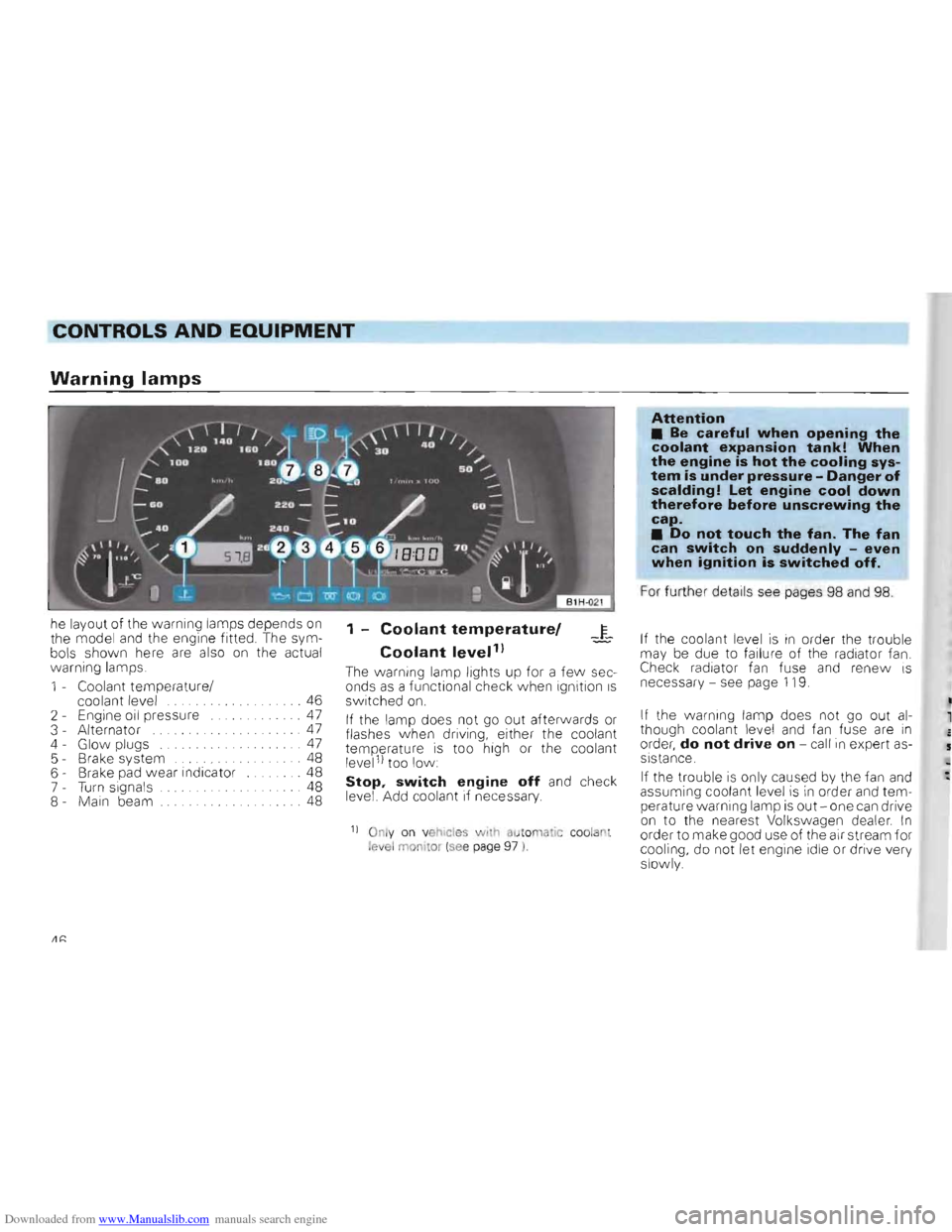
Downloaded from www.Manualslib.com manuals search engine CONTROLS AND EQUIPMENT
Warning lamps
Attention • Be careful when opening the coolant expansion tank! When the engine is hot the cooling system is under pressure -Danger of scalding! Let engine cool down therefore before unscrewing the cap_
• Do not touch the fan. The fan can switch on suddenly -even when ignition is switched off.
For furthe r details see pages 98 and 98.
1 -Coolant temperaturel _~_ If the coolant le vel is in orde r the trouble Coolant level') may be due to failure of the radiato r fan.
Check radiator fan fuse and renew is
T he wa rni ng lamp lights up for a few sec
necessary -see page 119.onds as a functional check when ign ition IS coo lant level .
. 46 switched on.
2 - Engine oil pressure ... .. 47 If the warning lamp does not go out al
If the lamp does not go out afterwards or 3 -Alternator . 47 though coolant level and fan fuse are inflashes when driving, either the coolant 4 -Glow plugs ... 47 orde r, do not drive on -call in expe rt astempe ratur e is too high or the coolant 5 -Brake system .. 48 sistance
.
level1 l too low: 6 -Brake pad wear indicator .48 If the trouble is only caused by the fan andStop, switch engine off and check7 -Turn signals 48
assuming coolant level is in order and temlevel . Add coolant if necessary . 8 -Main beam .
48
perature warning lamp is out -one can drive on to the nearest Volkswagen dealer. In 11 Only 011 vehicl es wi h a t omatic coolant order to make good use of the air stream for level lllonit or (see page 97 l. cooling , do not let engine idle or drive very
slowly .
he
layout
of the warning lamps depends on the model and the engine fitted. The sym
bols shown here are also on the actual
warn ing lamps.
1 -Coolant temperature /
Page 49 of 156
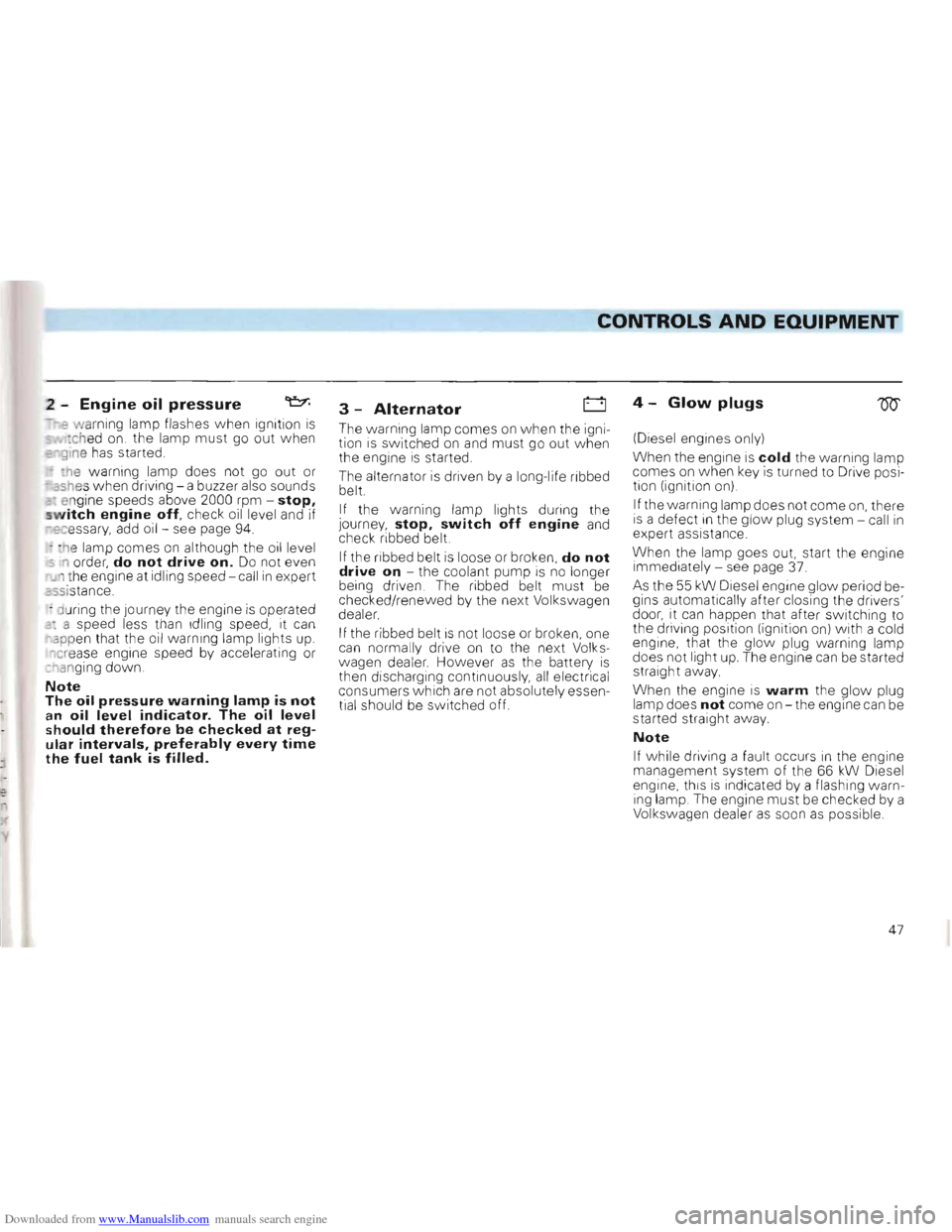
Downloaded from www.Manualslib.com manuals search engine CONTROLS AND EQUIPMENT
2 -Engine oil pressure ~
e wa rning lamp flashes when ignition is :ched on. the lamp must go out when ,=~g ne has started.
, 'Il e warning lamp does not go out or
ash es when driving -a buzzer also sounds
-' e!,gine spe,eds above 2000 rpm -stop, switch engine off, check oil level and if ecessary, add oil -see page 94.
- - he lamp comes
on although the oil level 5 n order, do not drive on. Do not even "'., t he engine at idling speed -call in expert ~slstance.
-du ring the Journe y the engine is operated
a : a speed less than idling speed, it ca n ~ appen that the oil warning lamp lights up. "crease engine speed by accelerating or :'langing down .
Note Th e oil pressure warning lamp is not an oil level indicator. The oil level shou.'d therefore be checked at reg, ular Intervals, preferably every time the fuel tank is filled.J
3 -Alternator
The warning lamp comes on w hen the igni
tion IS sWitched on and must go out when
the engine is started .
The alternator
is driven by a long-life ribbed
belt.
If the warning lamp lights during the
Journey ,
stop, switch off engine and
check ribbed belt.
If
t~e ribbed belt is loose or broken, do not
drive on -the coolant pump is no longer
being driven. The ribbed belt must be
checked/renewed by the next Volkswagen
dealer.
If the ribbed belt
is not loose or broken, one
can normally drive on to the next Vo lks
wag en dea ler. However as the battery is
then discharging co ntinuously , all electrical
consumers which are not absolutely essen
tial should be switched off.
4 -Glow plugs
(Diesel engines only)
When the engine
is cold the w arning lamp
come s on when key IS turned to Drive posi
tion (ignition on)
If the warning lamp does not come on, there IS a defectln the glow plug system -call in expert assistance.
When the lamp goes out, start the engine
Immediately -see page 37.
As the 55 kWDiesel engine glow period be
gins automatically after closing the drivers'
door,
It can happen that after switching to
the driving position (Ignition on) with a cold
engine, that the glow plug warning lamp
does not light up . The engine
can be started
straight away
When the engine
is warm the glow plug
lamp does not come on -the engine ca n be started straight away
Note
If while driving a fault occurs in the engine
management system of the 66 kW Diesel
engine, this
is indicated by a flashing warnIng lamp The engine must be checked by a
Volkswagen dealer as soon as possible.
47
Page 75 of 156
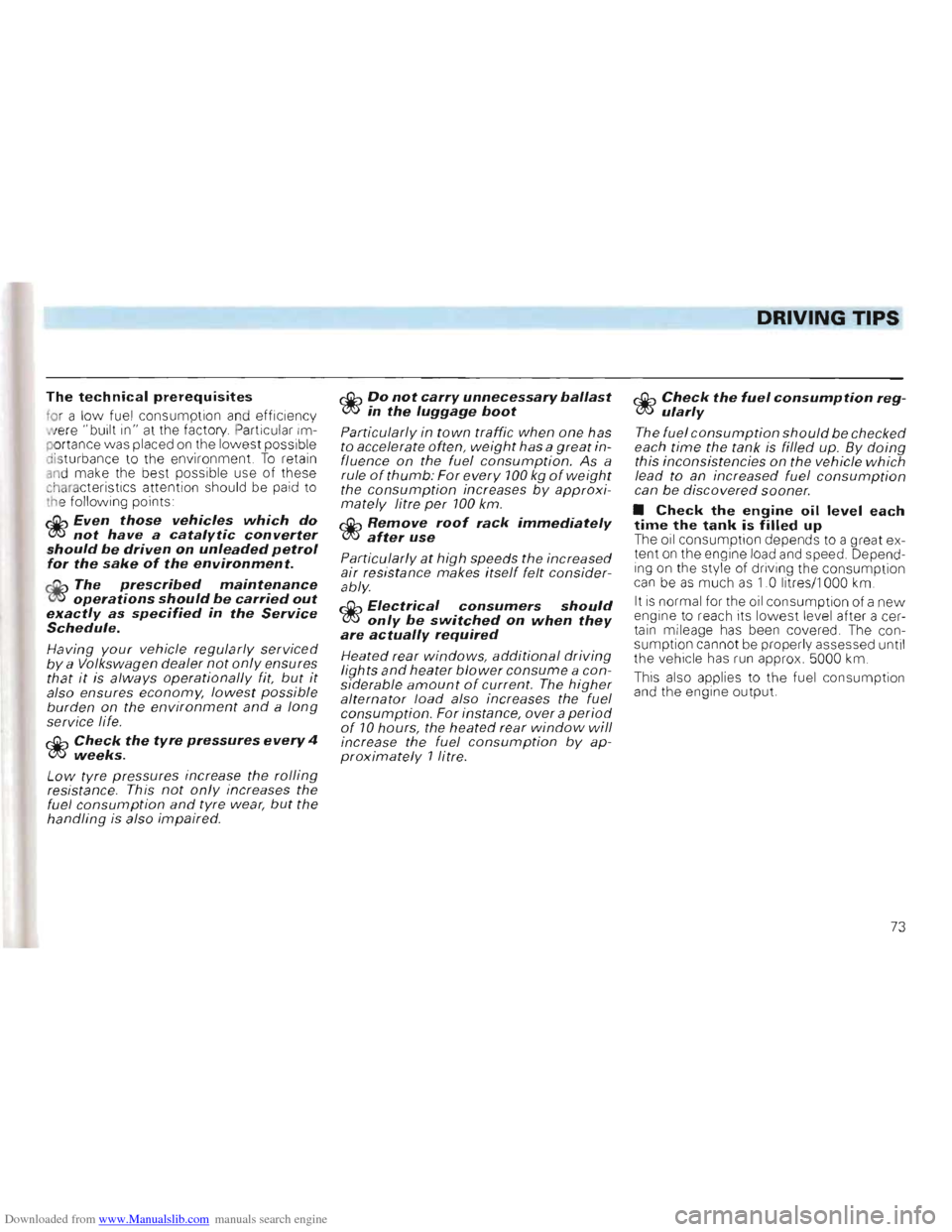
Downloaded from www.Manualslib.com manuals search engine DRIVING TIPS
The technical prerequisites
for a low fuel consumpt ion and efficienc y "" ere " built in" at the factory. Particular Im
p ortance was placed on the lowes t possible
d is turban ce to the enviro nme nt. To retain and make the best possible use of these characteristics attent ion should be paid to the fo llow ing points
~Even those vehicles which do W not have a catalytic converter should be driven on unleaded petrol for the sake of the environment.
~The prescribed maintenance W operations should be carried out exactly as specified in the Service Schedule.
Having your vehicle regularly serviced by a Volkswagen dealer not only ensures that it is always operationally fit, but it also ensures economy, lowest possible burden on the environment and a long service life.
~Check the tyre pressures every 4 W weeks.
Low tyre pressures increase the rolling resistance. This not only increases the fuel consumption and tyre wear, but the handling is also impaired.
~Do not carry unnecessary ballast W in the luggage boot
Particularly in town traffic when one has to accelerate often, weight has a great influence on the fuel consumption. As a
rule ofthumb: For every 100 kg ofweight the consumption increases by approximately litre per 100 km.
~Remove roof rack immediately Wafter use
Particularly at high speeds the increased air resistance makes itself felt considerably.
~Electrical consumers should W only be switched on when they are actually required
Heated rear windows, additional driving lights and heater blower consume a considerable amount of current. The higher alternator load also increases the fuel consumption. For instance, overa period of 10 hours, the heated rear window will increase the fuel consumption by approximately 1 litre.
~Check the fuel consumption regW ularly
The fuel consumption should be checked each time the tank is filled up. By doing this inconsistencies on the vehicle which lead to an increased fuel consumption can be discovered sooner.
• Check the engine oil level each time the tank is filled up The oil consumption depends to a g reat ex
tent on the engine load and speed. Depend
ing on the style of driving the consumption
can be as much as 1 .0 litr es/1 000 km .
It
IS no rmal fo r the oil consumption of a ne w
engine to reach its lowest level after a cer
tain mileage has be en covered . The con
sumption cannot be properly assessed until
the vehicle has run appro x. 5000 km.
This also applies to the fuel consumption
and the engine output.
73
Page 96 of 156
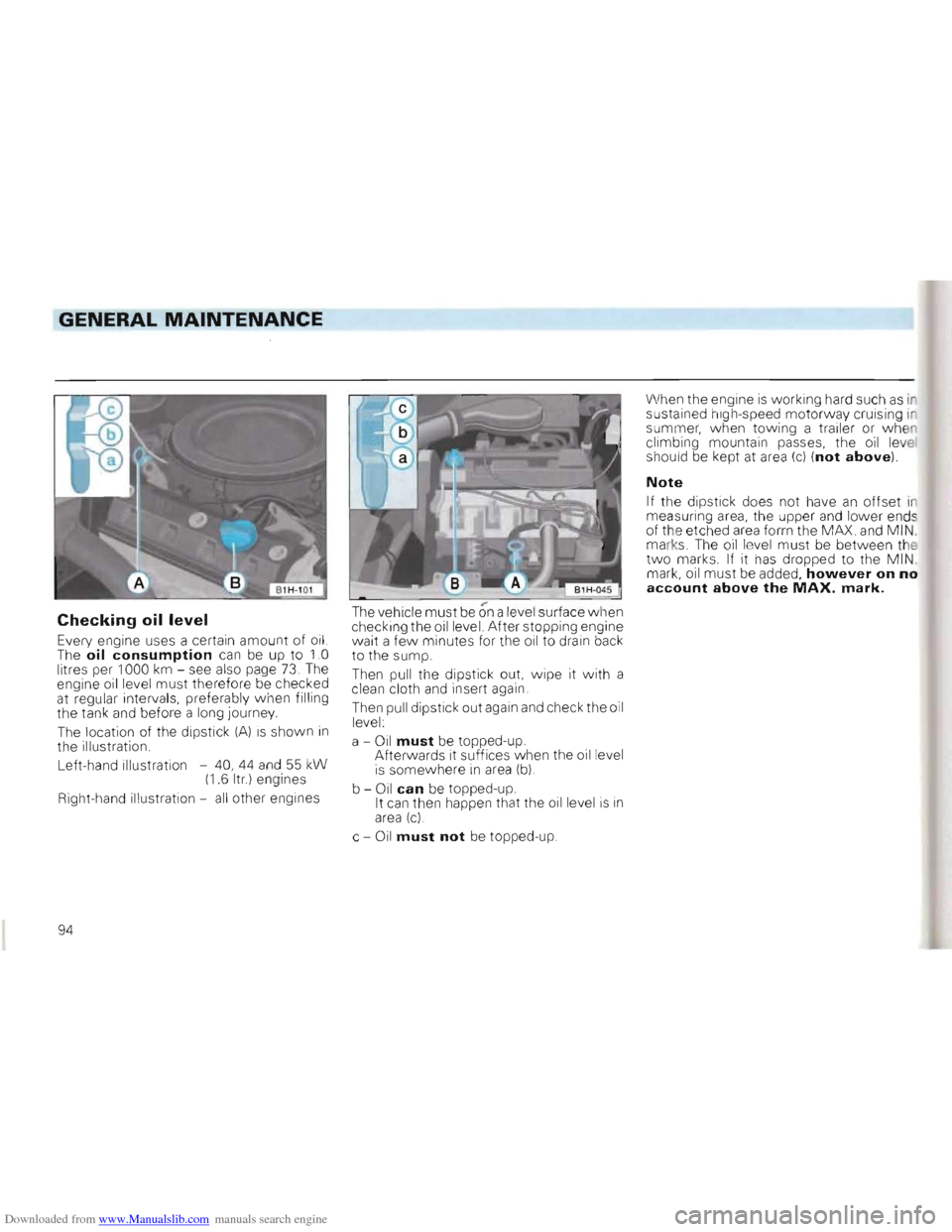
Downloaded from www.Manualslib.com manuals search engine GENERAL MAINTENANCE
Checking oil level
Every eng ine uses a certain amount of oil. The oil consumption can be up to 1.0
litr es per 1000 km -see also page 73. The
engine oil l eve l must therefore be ch ecke d
a t regula r int ervals, preferab ly w hen fillin g
the tank and before a long Journey.
The locat ion of the dipst ick (A) IS shown in th e illustration.
Left-hand illustration -40 , 44 an d
55 kW (1 .6 Itr) en gi nes
Right-hand illustration -
all other engines
The ve hicle must be on a leve l surface when checking the oil level. A fter stopping engine
wa it a fe w minutes for the oil to drain back
to the sum p.
T hen pu ll the dipstick out, wipe it with a
clean cloth and insert again
Then pull dipstick out again
and check th e oi l
level :
a -
Oil must be topped-up.
Afterwards it suffices when the oil level
is somewhere in area (b)
b -Oil can be topped-up.
I t can then happen that the oil level is in area (c)
c -Oil must not be topped-up. When
the engine
is working hard such as ir
sustained high-speed motorway cruisin g in
summer, when towing a trailer or w he n
c limbing mountain passes , the o
il lev e! should be kept at area (c) (not above).
Note
If t he dipstick does not have an offset in
meas uring area, the upper and lower ends
of the etched area forrn the MAX. and MIN .
marks. The oil level must be between the two marks. If it has dropped to the M I N . mark, oil mu st be added, however on no account above the MAX. mark.
94
Page 97 of 156
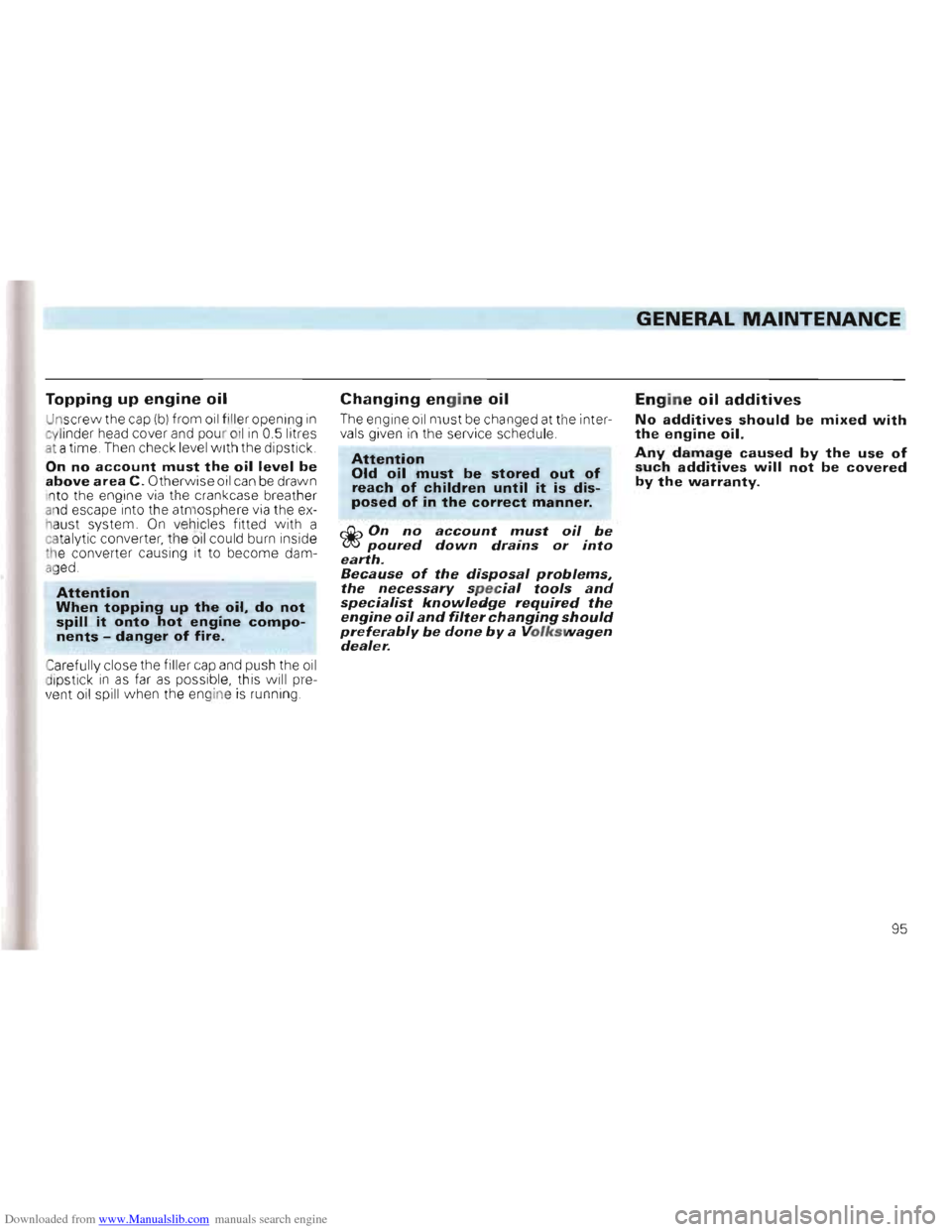
Downloaded from www.Manualslib.com manuals search engine GENERAL MAINTENANCE
Topping up engine oil
Unscrew the cap (b) from oil filler ope ning in cylinder head cover an d po ur 0 11 in 0 .5 litr es
at a time. Then check le ve l with th e dipst ic k .
On no account must the oil level be above area C . Otherwise oil can b e drawn
n to the engine via the crankcase breathe r
a n d escape into the atm osphere via th e ex·
h aust system. On ve hicl es fitted with a catalytic conve rte r, t he oil could burn inside the conve rter causing it to become dam·
a ged
Attention When topping up the oil. do not spill it onto hot engine components -danger of fire.
C arefully close the filler cap a n d push the oil ipsti ck in as far as possible, this w ill pre
vent oil spill when the engine is running .
Changing engine oil
The engine oil must be changed at the inter
v a ls g iven in the ser v ice sch e d ule .
Attention Old oil must be stored out of reach of children until it is disposed of in the correct manner,
r1Ib On no account must oil be ~poured down d,'ain s or into earth. Because of the disposal problems, the necessary special tools and specialist knowledge required the engine oiland filter ch anging should preferably be done by a Volkswagen dealer.
En gin e oil additives
No additives should be mixed with
the engine oil.
A ny damage caused by the use of
su ch additives will not be covered
by the warranty.
95
Page 98 of 156
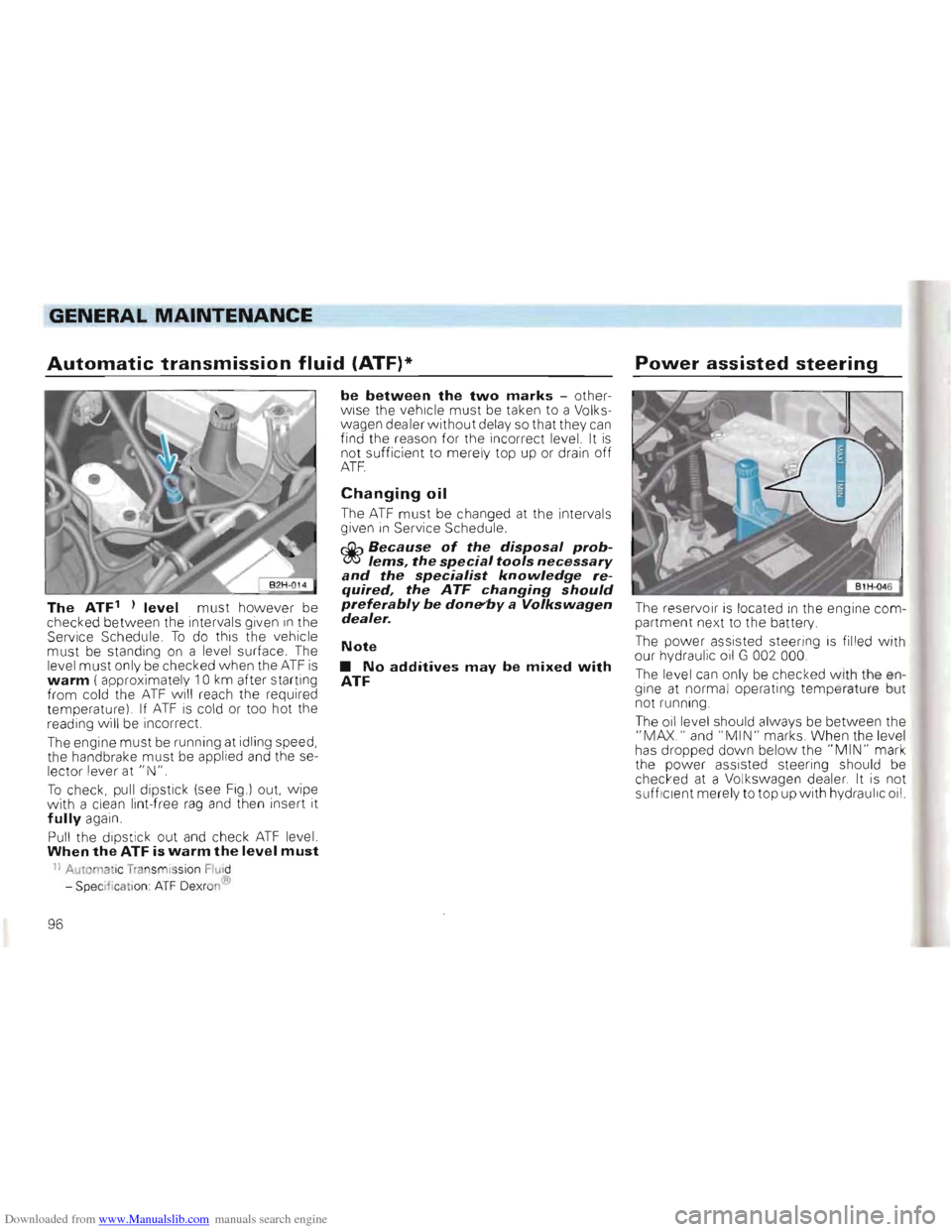
Downloaded from www.Manualslib.com manuals search engine GENERAL MAINTENANCE
Automatic transmission fluid (ATF)*
The ATF' ) level must however be
checked between the interva ls given in the
Service Schedule. To do this the vehicle
must be standing on a level surface. The level must only be checked when the ATF is warm ( approximate ly 10 km afte r starting
from cold the ATF will reach the required
temperature). If ATF is cold or too hot the
reading w ill be incorrect.
The engine must be running at idling speed,
the handbrake must be appl ied and the se
lector lever at "N ".
To check, pull dipstick (see Fig .) out. wipe
w ith a clea n lint -free rag and then insert it fully again.
Pull the dipstick out and check ATF level. When the ATF is warm the level must
11 Automat ic Transm is sion Fluid
- Spe cif ic ati on ATF Dexr on®
be between the two marks -other
w ise the vehicle must be taken to a Volks
wagen dealer without delay so that they can find the reason for the incorrect level. It is not sufficient to merely top up or drain off ATF.
Changing oil
The ATF must be changed at the intervals
given in Service Schedule .
r£il:-, Because of the disposal prob~lems, the special tools necessary and the specialist knowledge required, the ATF changing should preferably be donfY'by a Volkswagen dealer.
Note
• No additives may be mixed with ATF
Power assisted steering
The reservoir is located in the engine com
partment nex t to the battery.
The power assisted steering is fil led with
our hydraulic oil G 002 000.
The leve l can only be checked With the en
gine at normal operating temperature but
not running .
The oil level should always be between the
"MAX." and "MIN" m arks. When the leve l
has dropped down below the "MIN" mark
the power assisted steering should be
ched:ed at a Volkswagen dealer. It is not
suff iCient merely to top up with hy draulic oil.
96
Page 99 of 156
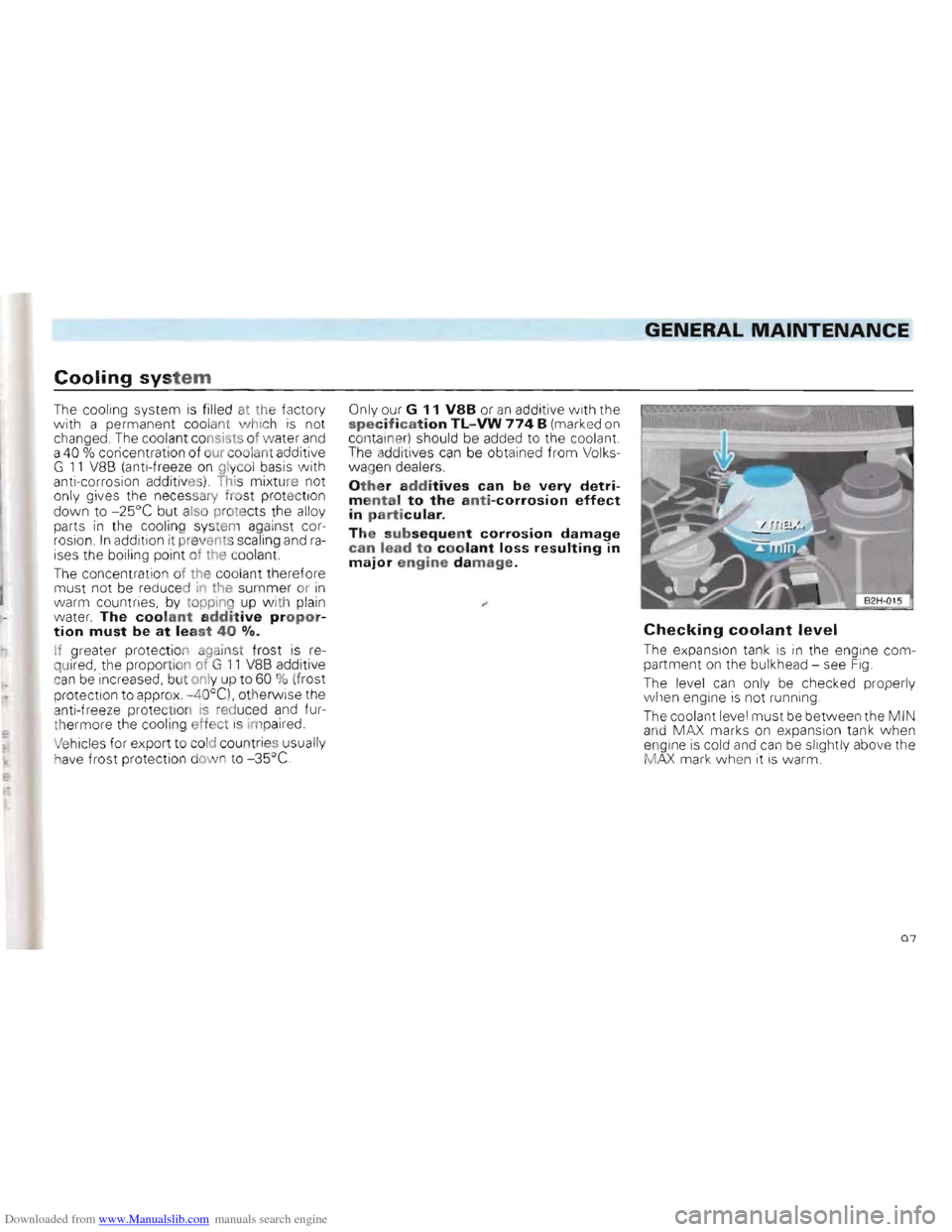
Downloaded from www.Manualslib.com manuals search engine GENERAL MAINTENANCE
Cooling system
The cooling system is filled at the factory with a perman ent coolant whic h is not
changed . The coo lant consists of w ater and a 40 % concent ration of our coolant additive
G 11 V8B (anti-f reeze on glycol basi s with
anti-corrosion additives). Thi s mi xture not
only gives the necessary frost prot ection
down to -25°C but also pro te cts the allo y
parts in the cooling system against cor
rosion. In add it ion it pr event s scal ing and raises the boiling point of the coo lant
The concentr atio n of the co olant therefore
must not be reduce d in the summer or in
wa rm countries, by tOPPing up with plain
w ater. The coolant additive proportion must be at least 40 %.
If greater protection against frost is re
qu ired, th e propor tion of G 11 V8B additive
c a n be increased, but onl y up to 60 % (Irost
prot ection to appr ox. -40 Cl. oth erwise the
a n ti-freeze prot ection is red uced and fur
t h ermore the cool ing effec t is im paired .
Vehicles for expor t to cold cou ntries usually
h ave frost protection down to -35°C.
Only our G 11 V8B or an addi tive with the specification TL-VW 774 B (ma rked on container ) should be added to the coolant.
The ad dit ive s can be obtained from Volks
w ag
en dealer s.
Other additives c a n b e very detrimental to the anti·corrosion effect in particular.
The subsequent corro sion damage can lead to coolant loss resulting in major engine damage.
Checking coolant level
The expansion tank is in the engine com
p artm ent on the bulkhead -see Fig
The level can o nly be checked properly
w he n engin e is not running .
The coo lant level must be bet ween the MIN
and Mt>,X marks on e xpansion tank when
engine is cold and can be slightly above the
MAX mark when it is warm .
07
Page 101 of 156
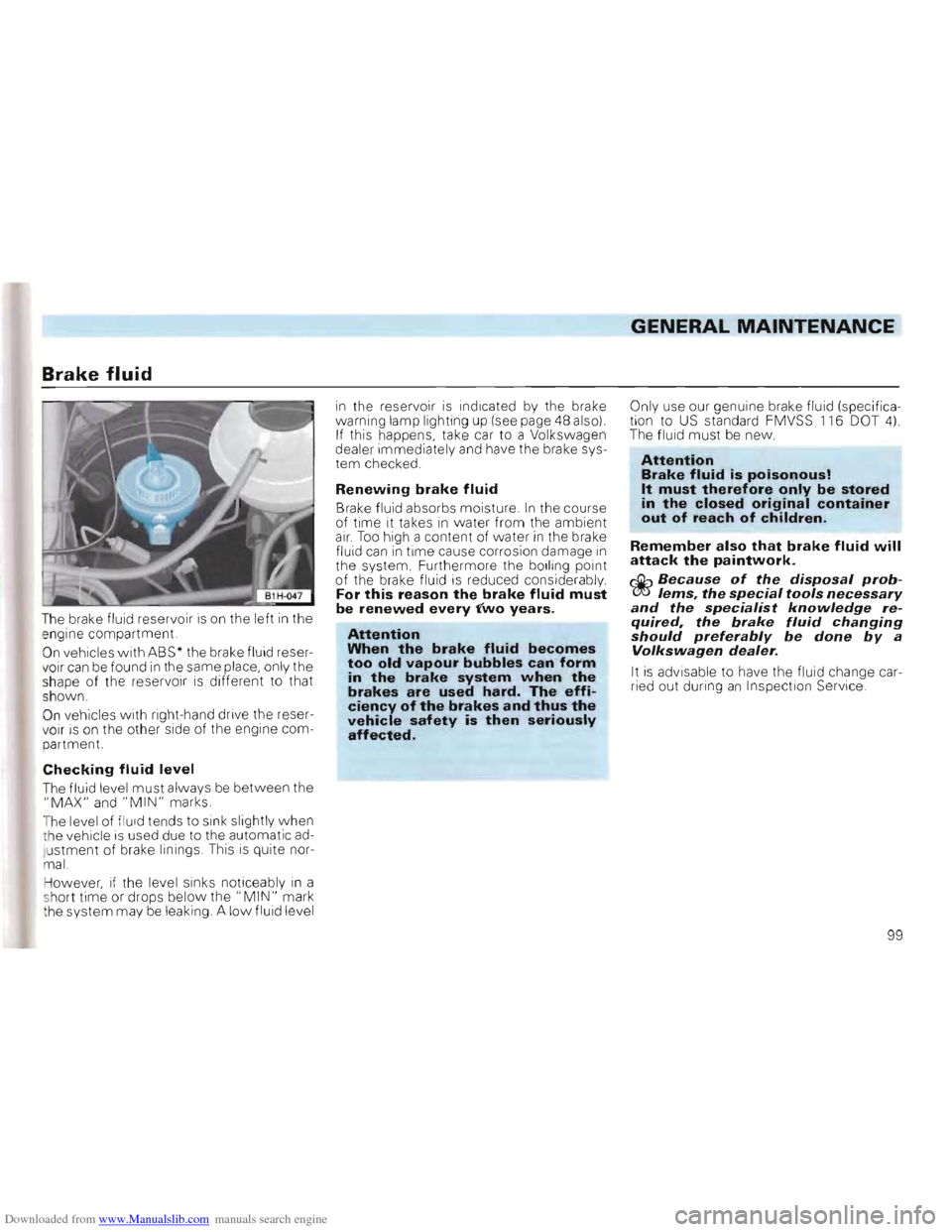
Downloaded from www.Manualslib.com manuals search engine GENERAL MAINTENANCE
Brake fluid
The brake fluid reservoir is on the left in the
e ngine compartment.
O n vehicles with ABS* the brake fluid reser
voir
can be found in the same place, only the
s hape of the reserv oir is different to that
s hown .
O n
vehicles with right-hand drive the reser
voir is on the other side of the engine com
p artment.
Checking fluid level
T he fluid level must always be between the
" MAX" and "MIN" marks.
T he
level of flu id tends to sin k slightly when the vehicle is used due to the automatic adJu stment of brake linings . This IS quite nor
mal.
H owever, if the level sinks noticeably in a
s h ort time or drops below the" MIN" mark
t h e system may be leaking. A low fluid level
in the reservoir is indicated by the brake
wa rning lamp lighting up (see page 48 also)
If this happens, take car to a Volkswagen
dealer immediately and have the brake sys
tem checked.
Renewing brake fluid
Brake fluid absorbs moisture. In the course
of time it takes in water from the ambient air. Too high a content of wa ter in the brake
fluid can In time cause corrosion damage in the system Furthermore the boiling point
of the brake fluid IS reduced considerably. For this reason the brake fluid must be renewed every f'wo years.
Attention When the brake fluid becomes too old vapour bubbles can form in the brake system when the brakes are used hard. The efficiency of the brakes and thus the vehicle safety is then seriously affected.
Only use our genuine brake fluid (spec ifica
tion to US standard FMVSS 116 DOT 4). The fluid must be new.
Attention Brake fluid is poisonous! It must therefore only be stored in the closed original container out of reach of children.
Remember also that brake fluid will attack the paintwork.
,.Q,., Because of the disposal prob
~lems, the special tools necessary
and the specialist knowledge re
quired, the brake fluid changing should preferably be done by a Vo/kswagen dealer.
It is advisable to have the fluid change car
ried out during an Inspection Service.
99